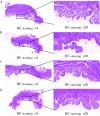[Optimization study of an animal model for interstitial cystitis/bladder pain syndrome based on the dose effect of cyclophosphamide]
- PMID: 39397473
- PMCID: PMC11480539
- DOI: 10.19723/j.issn.1671-167X.2024.05.024
[Optimization study of an animal model for interstitial cystitis/bladder pain syndrome based on the dose effect of cyclophosphamide]
Abstract
Objective: To evaluate the efficacy of cyclophosphamide (CYP) at different doses in replicating the symptoms of interstitial cystitis/bladder pain syndrome (IC/BPS) in an animal model, thereby providing an experimental basis for understanding the pathophysiology of IC/BPS and assessing treatment strategies.
Methods: Twenty-eight female Sprague-Dawley rats aged seven weeks were divided into four groups: Group a (25 mg/kg CYP), group b (75 mg/kg CYP), group c (125 mg/kg CYP), and group d (a control group). The rats were injected intraperitoneally with either CYP or saline solution. Evaluations included urine spot tests, von Frey filament pain threshold tests, urodynamic examinations, and histological assessments.
Results: The study found that the 25 mg/kg CYP dosage significantly outperformed higher doses in simulating bladder dysfunction and inflammatory responses while minimizing the impact on the rats' physiological functions. Specifically, urine spot area, group a showed a significant reduction in urine spot area compared with the control group (P < 0.05), while groups b and c did not show significant differences. Pain threshold: The von Frey filament test indicated increased visceral pain in group a, aligning closely with IC/BPS patient symptoms, without a significant increase in urination frequency. Urodynamic assessments: Group a exhibited decreased bladder compliance and reduced maximum bladder capacity (P < 0.05), with no significant differences in baseline bladder pressure and maximum detrusor pressure across all groups. Histological analysis: Hematoxylin-eosin (HE) staining revealed that bladder tissue in group a had moderate inflammatory reactions, whereas groups b and c showed severe inflammation and tissue damage, correlating with the higher doses of CYP. Furthermore, the urine spot tests and von frey filament tests provided quantitative data supporting the model's reliability, urine spot count, group a had an average urine spot count of (15±3) spots, significantly higher than the control group's (5±2) spots (P < 0.01). Nociceptive score: Group a nociceptive score increased to 0.5±0.1, indicating heightened pain sensitivity compared with the control group 0.10±0.05 (P < 0.01).
Conclusion: The 25 mg/kg CYP demonstrated significant advantages in simulating the key features of non-ulcerative IC/BPS, summarizing the main aspects of the human condition, including persistent visceral pain and mild inflammatory reactions in bladder tissue. These findings offer substantial experimental support for drug development and treatment research in IC/BPS and provide new insights into the complex patho-physiology of the disease.
目的: 评估不同剂量的环磷酰胺(cyclophosphamide,CYP)诱导的间质性膀胱炎/膀胱痛综合征(interstitial cystitis/bladder pain syndrome, IC/BPS)动物模型模拟疾病症状的准确性与可重复性,以期为IC/BPS的病理生理学研究和治疗策略评估提供实验模型依据。
方法: 选用7周龄的Sprague-Dawley雌性大鼠28只分为a组(25 mg/kg CYP)、b组(75 mg/kg CYP)、c组(125 mg/kg CYP)和d组(对照组)4组,每组7只,通过腹腔注射CYP或生理盐水建立动物模型,评估指标包括尿斑实验、von Frey纤维触痛实验、尿动力学检查,以及组织学分析。
结果: 25 mg/kg CYP剂量的大鼠在模拟IC/BPS膀胱功能障碍和炎症反应方面显著优于其他CYP剂量组,且对生理功能影响较小。所有剂量CYP处理的大鼠都表现出膀胱炎症,但25 mg/kg剂量的症状与IC/BPS临床特征更为一致。此外,25 mg/kg CYP剂量组大鼠膀胱顺应性降低,内脏疼痛增加,但未显著增加排尿频率,与IC/BPS患者表现相似。
结论: 25 mg/kg的CYP剂量在模拟非溃疡性IC/BPS的关键特征方面表现出明显的优势,对未来IC/BPS的研究和治疗策略提供了重要参考。但尽管如此,由于IC/BPS的多因素性质,未来研究需要探索更多诱导手段,以复现疾病的复杂病理过程。
Keywords: Animal Model; Bladder Pain Syndrome; Cyclophosphamide; Interstitial Cystitis; Urodynamics.
Conflict of interest statement
Figures
Similar articles
-
Expression and function of CCL2/CCR2 in rat micturition reflexes and somatic sensitivity with urinary bladder inflammation.Am J Physiol Renal Physiol. 2013 Jul 1;305(1):F111-22. doi: 10.1152/ajprenal.00139.2013. Epub 2013 Apr 17. Am J Physiol Renal Physiol. 2013. PMID: 23594826 Free PMC article.
-
Si-Ni-San Ameliorates the Clinical Symptoms of Interstitial Cystitis/Bladder Pain Syndrome in Rats by Decreasing the Expression of Inflammatory Factors.Arch Esp Urol. 2023 Jul;76(5):347-356. doi: 10.56434/j.arch.esp.urol.20237605.41. Arch Esp Urol. 2023. PMID: 37545154
-
[Urodynamic and histological evaluation of cyclophosphamide-induced bladder pain syndrome in SD rats].Beijing Da Xue Xue Bao Yi Xue Ban. 2022 Aug 18;54(4):735-740. doi: 10.19723/j.issn.1671-167X.2022.04.024. Beijing Da Xue Xue Bao Yi Xue Ban. 2022. PMID: 35950400 Free PMC article. Chinese.
-
Experimental murine models of interstitial cystitis/bladder pain syndrome: A review.Histol Histopathol. 2025 May;40(5):635-644. doi: 10.14670/HH-18-837. Epub 2024 Oct 23. Histol Histopathol. 2025. PMID: 39523811 Review.
-
Urinary IL-33 and galectin-3 increase in patients with interstitial cystitis/bladder pain syndrome (review).Georgian Med News. 2014 Jul-Aug;(232-233):12-5. Georgian Med News. 2014. PMID: 25214264 Review.
References
Publication types
MeSH terms
Substances
LinkOut - more resources
Full Text Sources
Medical



